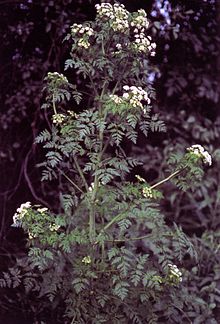

Conium alkaloids are natural products of the piperidine alkaloid type.
Occurrence
Conium alkaloids are found in spotted hemlock. The mature fruits may contain up to 3.5% alkaloids.
Representative
The main alkaloid is coniine. Other representatives are γ-conicein, conhydrin, pseudoconhydrin, and N-methylconiin.
Most Conium alkaloids are liquid at room temperature.
Properties
500 mg of coniin is fatal to a human. Coniin is the poison of the spotted hemlock. Poisoning results in nausea, vomiting, salivation, and diarrhea. Within half an hour to an hour, paralysis of the chest muscles occurs, which is fatal.
History
In ancient times, aqueous extracts of this plant (hemlock cup) were administered. In 399 BC, Socrates was sentenced to death by the cup of hemlock as a "free thinker and seducer of youth."
References
- ^ Eintrag zu Conium-Alkaloide. In: Römpp Online. Georg Thieme Verlag, retrieved 29 April 2020.
- Brockhaus ABC Chemie, VEB F. A. Brockhaus Verlag Leipzig 1965, p. 714.
- A. Wollrab (2009), Organische Chemie (3 ed.), Berlin Heidelberg: Springer, p. 1053, ISBN 978-3-642-00781-1
- ^ H. Latscha, U. Kazmaier (2016), Chemie für Biologen (4 ed.), Berlin Heidelberg: Springer Spektrum, p. 682, ISBN 9783662477830
- Adalbert Wollrab (2009), Organische Chemie (4 ed.), Berlin Heidelberg: Springer Spektrum, p. 1025, ISBN 978-3-642-45143-0


